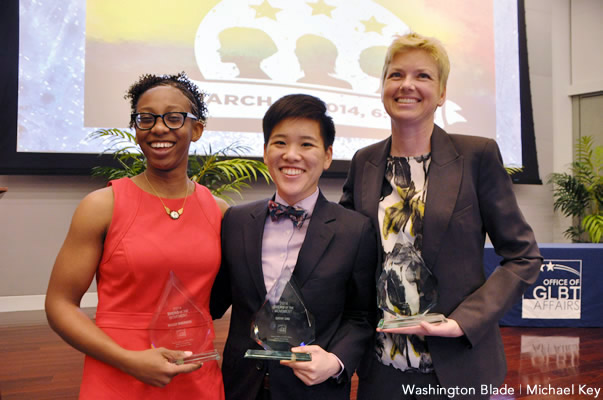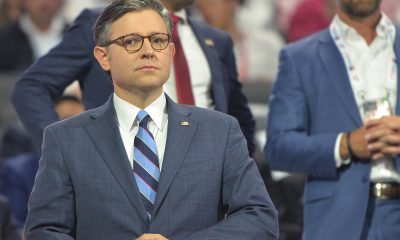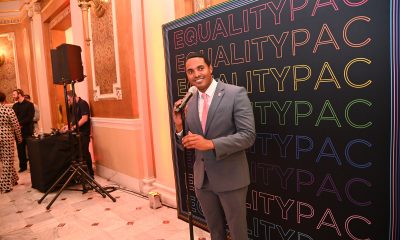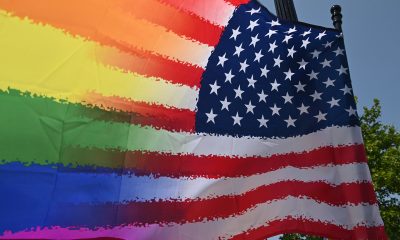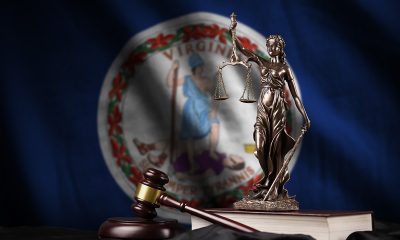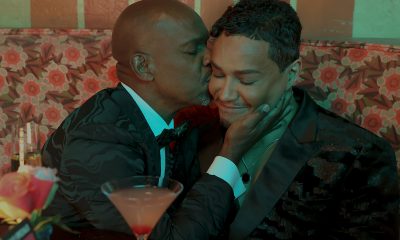homepage news
10 years later, firestorm over gay-only ENDA vote still informs movement
Controversy over bill helped ensure commitment to inclusion
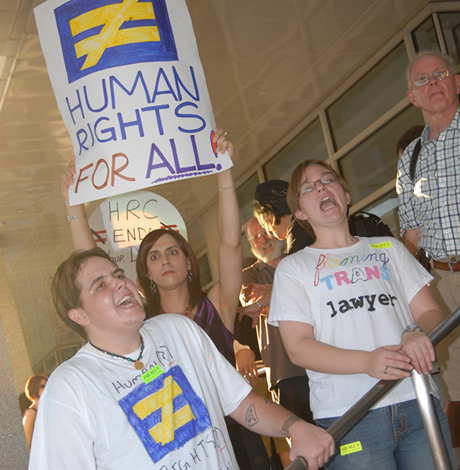

Protesters demonstrate against the Human Rights Campaign in 2007 over support for a gay-only ENDA.(Washington Blade file photo by Henry Linser)
Ten years ago, a firestorm ignited in the LGBT community over a vote in the U.S. House that many transgender people remember vividly because it excluded them in favor of advancing employment non-discrimination protections to lesbian, gay and bisexual people.
The vote on the “gay-only” version of the Employment Non-Discrimination Act on Nov. 7, 2007, rocked the LGBT movement and prompted protests against the Human Rights Campaign and gay former Rep. Barney Frank (D-Mass.), who backed the bill, arguing it was the best that could be done at the time. The 10th anniversary of the vote is Tuesday.
But the omission galvanized transgender rights advocates to such an extent that for the next 10 years the LGBT movement committed to moving forward only legislation that included the full community — both at the state and federal level — and today advancement of a sexual-orientation only bill is impossible to imagine.
Dana Beyer, a Chevy Chase, Md.-based transgender activist who’s running for state Senate in Maryland, said the vote on the gay-only version of ENDA was “a landmark” for trans inclusion in the LGBT movement.
“Whenever I discuss the progress that we’ve made, which has been remarkable, I begin there because that was basically the first real battle for the trans community on the national stage and over the succeeding decade, we’ve made incredible progress,” Beyer said.
Beyer added from that time forward after the creation of United ENDA — an unprecedented coalition of more than 400 organizations that emerged to fight against trans exclusion —there have been with few exceptions “no instances of any gay activism or legislation that did not include trans people.”
Rebecca Juro, a New Jersey-based transgender activist and radio show host, said the reaction to the vote on the sexual-orientation only version of ENDA was a significant turning point.
“The reason why Barney Frank was able to introduce and get the kind of support he did in Congress was because there was a feeling [of] who cares, nobody knows about these people,” Juro said. “What that did was it said, ’No, no, no,’ you’re wrong.’ and people are going to call you out and it’s going to cost you politically and people are going to show up at the Human Rights Campaign galas and make it difficult for you to solicit money for your campaign.”
In the year Democrats assumed control of the U.S. House after more than a decade of Republican majorities, then-House Speaker Nancy Pelosi (D-Calif.) brought the gay-only version of ENDA to the floor after Frank determined an initial version of the bill that included protections based on gender identity wouldn’t get a majority vote in the chamber.
That version of ENDA would pass on the House floor by a vote of 235-184. (Among those voting in favor of the bill was Rep. Paul Ryan (R-Wis.), although he also voted in favor of a motion to recommit that would have killed the legislation.)
Voting “no” on the legislation were 25 Democrats, many of whom — such as Rep. Jerrold Nadler (N.Y.), former Rep. Anthony Weiner (N.Y.) and former Rep. Michael Michaud (Maine) — rejected the measure on the basis it lacked protections for transgender people. Then-Rep. Tammy Baldwin (D-Wis.), now a U.S. senator and still the only out lesbian in Congress, proposed an amendment to insert gender identity, but withdrew the measure before it could come to a vote.
Joe Solmonese, president of the Human Rights Campaign at the time of the vote, backed ENDA and 10 years later stood by his decision as a means to develop the legislation, citing “no hope of passing any legislation into law” with George W. Bush as president.
“It was a tactical decision to take a step in the direction of getting what we ultimately wanted, which was maybe a non-inclusive bill in the House, and inclusive bill in the Senate that would end up as a fully inclusive bill or that would end up as a fully inclusive bill by the time Obama became president,” Solmonese said.
Recalling a “great deal of debate within the community and the House” about whether sufficient votes for transgender inclusion were present, Solmonese said lawmakers pledged to LGBT activists support for a trans-inclusive bill before, then told Pelosi not bring such a measure to the floor.
“They sort of wanted it both ways,” Solmonese said. “They knew what they were supposed to do, but they didn’t want to do it.”
Frank said the vote on ENDA was “very important” because it paved the way for legislative victories on hate crimes protections and “Don’t Ask, Don’t Tell” repeal.
“One of the problems we’ve had historically — we don’t have it anymore — is members being afraid to vote for us because they thought they could be defeated, that it would be a tough vote,” Frank said. “So, here we had members voting for a bill that was a broad protections for LGB people and nobody lost because of it. That was very helpful in setting the foundation.”
In his book “A Life in Politics,” Frank recounts the deliberative process that went into bringing the gay-only version of ENDA to the House floor, maintaining Republicans would have sought to amend the bill to remove the transgender protections.
Baldwin disagreed with moving forward without transgender inclusion, Frank wrote, even though she ultimately voted for the bill. (Baldwin’s office didn’t respond to a request to comment for this article.)
“As we approached the final vote, Tammy did her own informal whip count and concluded we would have enough Democratic votes,” Frank wrote. “Speaker Pelosi, a strong supporter of the bill, asked Tammy for her count, checked it herself with the members, and decided that Tammy had been too optimistic — a conclusion that [former Rep. George Miller and I, based on our own work, fully agreed with. We did not have the votes for the inclusive-bill. It was sadly but unmistakably clear to Pelosi, Miller and me that we could pass ENDA only in its earlier form, covering only lesbian, gay and bisexual workers.”
Backing that move was the Human Rights Campaign, which continued to support the gay-only measure as one of five co-signers in a letter to Congress dated Nov. 6, 2007 organized by the Leadership Conference on Civil & Human Rights.
“With each significant step toward progress, the civil rights community has also faced difficult and sometimes even agonizing tradeoffs,” the letter said. “We have always recognized, however, that each legislative breakthrough has paved the way for additional progress in the future. With respect to ENDA, we take the same view.”
That vote sent a shockwave through the transgender community, which quickly marshaled opposition to the bill and protested any further advancement without their protections. Many angrily accused the Human Rights Campaign and Frank of abandoning the transgender community.
Mara Keisling, executive director of the National Center for Transgender Equality, said the vote was “one of the most important things that happened in the movement in the last 20 years.”
“We wanted everything to be about setting up for what the movement was after this vote happened, after the bill died for the year,” Keisling said. “What were the lessons the movement was going to learn, what was the lesson HRC was going to learn, what was the lesson Barney Frank was going to learn?”
The night before the vote, Keisling said, she received a call from Frank’s office and was informed “it was over” a for trans-inclusive version of ENDA. Together with Dave Noble, then policy director of the National LGBTQ Task Force, Keisling said she planned to write a letter to Baldwin in hopes she could influence the vote, but was told the gay-only ENDA would move forward.
That night, Keisling and Noble reached out to the National Center for Lesbian Rights and other groups to form a coalition against the trans omission. By morning more than 60 organizations had joined United ENDA, Keisling said, a coalition that refused to support the gay-only bill and pledged to work with lawmakers to support a trans-inclusive measure.
Keisling said other groups “were calling up slightly annoyed that they hadn’t been asked to sign on” and soon the coalition grew to several hundred members.
“It essentially was because Barney Frank and HRC had totally lost touch with what the community was,” Keisling said. “So they did not understand that this would not be alright with the community and we all found out very quickly in a matter of hours that it really was not, that the movement had really become an LGBT movement and it wasn’t going to fly to take trans people out. So not only were we against the vote happening, we were the leaders of being against the vote happening.”
The gay-only version of ENDA never reached Bush’s desk for his veto, nor did any version of the bill — trans-inclusive or otherwise — come up in the U.S. Senate even though Democrats controlled both chambers of Congress.
Had ENDA been brought to the floor for a vote in the Senate, the sponsor would likely have been the late Sen. Edward Kennedy, who was one of the rare champions of LGBT rights at the time.
Solmonese said he didn’t immediately remember why ENDA never came up in the Senate and said it “may have had to do with timing,” but said Kennedy would only have moved forward with a trans-inclusive bill, not a gay-only ENDA, as part of the strategy for the House vote.
“He understood and supported the rationale of having an overarching strategy,” Solmonese said. “George Bush is the president. This thing’s not going to get passed into law. You do one version in the House, an inclusive version in the Senate, the leadership of both chambers is such that the conference committee would likely end up with something that was fully inclusive, right?”
Keisling, however, said “there was no Senate plan” because the Democratic majority in the chamber was seen as too marginal to advance ENDA, nor did Kennedy ever express an aversion to the gay-only version of the bill.
“The plan was that Barney Frank and HRC thought that it was worth passing the gay-only bill through the House, just move the ball forward and get members on the record as Barney said many times,” Keisling said. “Everyone else believed that since it would never become law that year, we shouldn’t exclude anyone.”
Do the backers of the bill at that time have any regrets? Solmonese acknowledged a few even though he stood by his decision to support ENDA in 2007.
“I regret that I saw it one way, which was a step in building towards what all of us ultimately wanted and by no means a signal that that was the legislation that anybody would ultimately support, but the fact that many people didn’t see it that way and many people simply saw the symbolism around the act as one that was divisive to the community, that was never the intention of HRC or my intention, but I certainly regret that that’s the way that it unfolded,” Solmonese said.
Frank said his “regret was we didn’t have the votes” when asked about his approach and blustered at the suggestion anything else could have been done.
“I think to do nothing at all — that was the argument, if you can’t include everybody, you can’t include anybody — in the first place, that’s not the history of the civil rights movement,” Frank said. “I voted to help protect African Americans and immigrants and women. The civil rights movement…you move as much as you can as soon as you can and you build on that. So do I regret not trying hard to get votes? No, I tried as hard as I could to get the votes.”
‘The pendulum is all the way the other way’
Over the course of 10 years since that vote, it’s hard to imagine Congress — or any other legislative body — passing legislation that excluded transgender people. Each successful version of ENDA introduced and advanced in Congress has been trans inclusive and its supporters have defended that language against any objection it. The Equality Act, the successor to ENDA that would ban anti-LGBT discrimination in employment and in all aspects of civil rights law, has consistently been trans inclusive.
Keisling said the commitment to trans inclusion among LGBT groups is “almost total.”
“Most of the big LGBT organizations, including the legal organizations, the lion’s share of their work now is trans work and, no, I don’t think any of them would intentionally do work to cut trans people out. In fact, there are times that we have to talk people into doing things because they’re afraid trans people will think it means cutting them out when it doesn’t. So, yeah, the pendulum is all the way the other way, and then probably some extra.”
Drew Hammill, a Pelosi spokesperson, pointed to enactment of the Matthew Shepard & James Byrd Jr. Hate Crimes Prevention Act and his boss’ support for the Equality Act as evidence of her support for trans inclusion.
“Leader Pelosi was proud to lead the Congress as speaker in passing a fully inclusive hate crimes bill signed into law by President Obama in October of 2009,” Hammill said. “A top priority for the leader is the Equality Act, comprehensive legislation to amend the Civil Rights Act and protect LGBT Americans from discrimination on the basis of sexual orientation, gender identity and sex. The leader believes that this legislation would pass the Congress now should Speaker Ryan allow a vote.”
Times have changed for the Human Rights Campaign as well. In 2014, Chad Griffin, the current president of the Human Rights Campaign, apologized on behalf of his organization at the Southern Comfort transgender conference for having “done wrong by the transgender community in the past.”
Transgender work has become a major component of the LGBT group’s work. In recent years, the organization has opposed a gay-only non-discrimination bill in Michigan, worked to thwart the anti-trans House Bill 2 in North Carolina and successfully blocked an anti-trans bathroom bill in Texas. The organization has also opposed non-discrimination measures in Pennsylvania and Charlotte, N.C., without public accommodations protections, which were seen as a backdoor way of leaving out transgender people because of controversy over bathroom use.
Sarah McBride, who’s transgender and press secretary for the Human Rights Campaign, said in the past 10 years the organization is “proudly and unequivocally continuing to fight for trans-inclusive protections” and will only back legislation that is fully inclusive.
“From Michigan to North Carolina to Birmingham, HRC has forcefully and aggressively blocked laws and policies that don’t protect every LGBTQ person from discrimination while fighting to extend robust protections across the country,” McBride said. “We are also working to accelerate the pace of progress in other ways, from raising the visibility of the transgender community, to incentivizing trans-inclusive healthcare through our Corporate Equality Index, to shining a spotlight on the epidemic of anti-transgender violence which is taking the lives of so many trans women of color.”
But 2007 wasn’t the last time there would be fighting within the LGBT community over ENDA. In 2013, major LGBT groups (again with the exception of the Human Rights Campaign) dropped support from a version of ENDA over the scope of its religious exemption, which would have provided leeway for religious institutions, like churches or religious schools, to discriminate against LGBT workers in non-ministerial positions even if the bill were to become law. In a reversal from 2007, the Senate passed the legislation, but it didn’t come up for a vote in the Republican-controlled House.
Although ENDA has never become law, a growing consensus has emerged in the courts that Title VII of the Civil Rights Act of 1964, which prohibits employment discrimination on the basis of sex, also applies to anti-trans discrimination. Four federal appellate courts — the First, Sixth, Ninth and Eleventh circuit courts of appeals — have determined employment discrimination against transgender people is barred under Title VII, as has the U.S. Equal Employment Opportunity Commission.
Keisling cautioned against too much reliance on laws against sex discrimination because “things are in flux,” noting U.S. Attorney General Jeff Sessions’ withdrawal of support for transgender protections under Title VII and President Trump’s appointment of anti-LGBT judges.
“We’re still convinced that the courts are on our side, cases and decisions have been building up to support us and actually [the idea] trans people are supported by sex discrimination is better supported than that gay people are,” Keisling said. “We just don’t exactly know how that’s going to maintain. We do know that there’s a handful of both sexual orientation and gender identity cases moving up through the court system, so what I say now might not be true a month from now and certainly will be changed somewhat in a year.”
Confidence in the legal landscape for trans protections under Title VII is at such a point that a pending petition filed by Lambda Legal before the U.S. Supreme Court seeking a nationwide ruling for gay protections under the law, but not explicit trans protections, hasn’t registered as trans exclusion. The petition was filed on behalf of lesbian plaintiff Jackie Evans after the U.S. 11th Circuit Court of Appeals ruled against her.
Beyer said she’s not bothered by the petition and it should only upset transgender activists “who don’t bother to parse the specifics” and recognize the transgender victories in lower courts.
“We could have easily won [trans protections] nationwide first,” Beyer said. “In this case, sexual orientation has been viewed differently and most courts haven’t wanted to touch it until the Hively case in the 7th Circuit took it, and now we’ve got Evans. That’s beginning to change. I’m certainly not at all offended by that because this is the way you go. You have a case and the case can’t equally be broadened to include different classifications simply because the community would like it.”
The social scene, in contrast to advocacy groups and the legal landscape, may not be as advanced in accepting transgender inclusion despite the explosion over ENDA 10 years ago. Transgender rights advocates noted a distinction between the LGBT community at large in accepting transgender people and advocacy groups.
Beyer said she doesn’t see transgender inclusion at the social level “anywhere near as advanced” as the current legal landscape.
“Acceptance, affirmation in the general culture is one thing, but the fact that, say, 35 percent of Americans do know a trans person, doesn’t mean that people are that much more comfortable with trans people,” Beyer said. “I think on balance they are, but not overwhelmingly so.”
Efforts to resist trans inclusion in the movement on occasion still emerge, although they’re rare and don’t represent mainstream LGBT views. In 2015, a petition was posted on Change.org titled “Drop the T” urging major LGBT organizations to “disassociate themselves from the transgender movement and return to representing their base support of gay men and lesbians.” The petition, signed by 3,227 people, had no impact on transgender advocacy at LGBT groups.
But transgender advocates also saw a generational divide in the approach to trans inclusion on the social scene that meets what is now seen at the advocacy level.
Juro said college-aged LGBT activists just beginning to come into the movement have a much different view of trans inclusion than their LGBT elders.
“They’re all like, no, you cannot separate, we’re all in this together and trying to say we’ll get rights for gay people without trans people is unacceptable,” Juro said. “And our youth, let’s be honest, are the ones who are driving the community. There the ones who get out there with the signs and the marches. People my age, 55, and old farts, we’re not always as active as we used to be and these are the kids who are driving the movement.”
In some respects, the transgender movement has evolved in strength to take on challenges on its own. Just recently, the National Center for Transgender Equality formed a 501(c)(4) political arm and the Breakthrough Fund, a political action committee and offshoot of the Trans United Fund run by transgender activists, launched with the goal of electing transgender people to public office.
Beyer said the transgender movement is rising to the occasion now that transgender issues have become the focus after many victories on gay rights.
“I think the grassroots trans community has seized the initiative simply because after marriage, after Obergefell, it seemed like the air went out of the gay balloon,” Beyer said. “On a local level, there are still black trans women being murdered. There’s still difficulty getting jobs for many trans people, particularly the younger ones. So, there’s a lot of work that needs to be done.”
With the LGBT movement changing dramatically, Keisling said “the LGBT movement is quickly becoming a trans movement,” and now she’s concerned “we’re sending signals to the gay community that trans work is more important than gay work.”
Nonetheless, Keisling cited concerns about insufficient trans presence in places where existing infrastructure is based on gay rights, such as states that have state LGBT equality groups, but no trans groups.
“That’s fine as long as the LGBT movement is strong, but after marriage, if the movement’s weakening…that means trans people don’t have enough support from the LGBT group because it’s weakening but they don’t have the ability to have a strong trans group because there’s an LGBT group,” Keisling said. “I think that’s a conversation we have to start having more explicitly.”
homepage news
Honoring the legacy of New Orleans’ 1973 UpStairs Lounge fire
Why the arson attack that killed 32 gay men still resonates 50 years later
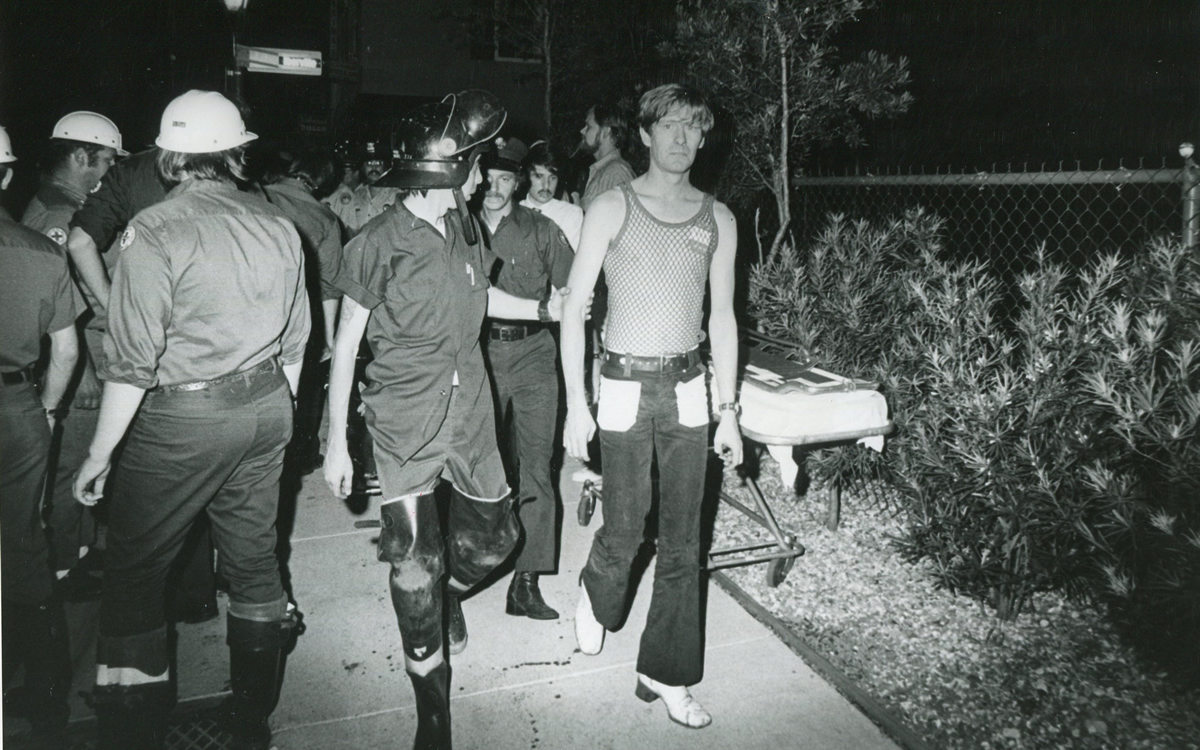
On June 23 of last year, I held the microphone as a gay man in the New Orleans City Council Chamber and related a lost piece of queer history to the seven council members. I told this story to disabuse all New Orleanians of the notion that silence and accommodation, in the face of institutional and official failures, are a path to healing.
The story I related to them began on a typical Sunday night at a second-story bar on the fringe of New Orleans’ French Quarter in 1973, where working-class men would gather around a white baby grand piano and belt out the lyrics to a song that was the anthem of their hidden community, “United We Stand” by the Brotherhood of Man.
“United we stand,” the men would sing together, “divided we fall” — the words epitomizing the ethos of their beloved UpStairs Lounge bar, an egalitarian free space that served as a forerunner to today’s queer safe havens.
Around that piano in the 1970s Deep South, gays and lesbians, white and Black queens, Christians and non-Christians, and even early gender minorities could cast aside the racism, sexism, and homophobia of the times to find acceptance and companionship for a moment.
For regulars, the UpStairs Lounge was a miracle, a small pocket of acceptance in a broader world where their very identities were illegal.
On the Sunday night of June 24, 1973, their voices were silenced in a murderous act of arson that claimed 32 lives and still stands as the deadliest fire in New Orleans history — and the worst mass killing of gays in 20th century America.
As 13 fire companies struggled to douse the inferno, police refused to question the chief suspect, even though gay witnesses identified and brought the soot-covered man to officers idly standing by. This suspect, an internally conflicted gay-for-pay sex worker named Rodger Dale Nunez, had been ejected from the UpStairs Lounge screaming the word “burn” minutes before, but New Orleans police rebuffed the testimony of fire survivors on the street and allowed Nunez to disappear.
As the fire raged, police denigrated the deceased to reporters on the street: “Some thieves hung out there, and you know this was a queer bar.”
For days afterward, the carnage met with official silence. With no local gay political leaders willing to step forward, national Gay Liberation-era figures like Rev. Troy Perry of the Metropolitan Community Church flew in to “help our bereaved brothers and sisters” — and shatter officialdom’s code of silence.
Perry broke local taboos by holding a press conference as an openly gay man. “It’s high time that you people, in New Orleans, Louisiana, got the message and joined the rest of the Union,” Perry said.
Two days later, on June 26, 1973, as families hesitated to step forward to identify their kin in the morgue, UpStairs Lounge owner Phil Esteve stood in his badly charred bar, the air still foul with death. He rebuffed attempts by Perry to turn the fire into a call for visibility and progress for homosexuals.
“This fire had very little to do with the gay movement or with anything gay,” Esteve told a reporter from The Philadelphia Inquirer. “I do not want my bar or this tragedy to be used to further any of their causes.”
Conspicuously, no photos of Esteve appeared in coverage of the UpStairs Lounge fire or its aftermath — and the bar owner also remained silent as he witnessed police looting the ashes of his business.
“Phil said the cash register, juke box, cigarette machine and some wallets had money removed,” recounted Esteve’s friend Bob McAnear, a former U.S. Customs officer. “Phil wouldn’t report it because, if he did, police would never allow him to operate a bar in New Orleans again.”
The next day, gay bar owners, incensed at declining gay bar traffic amid an atmosphere of anxiety, confronted Perry at a clandestine meeting. “How dare you hold your damn news conferences!” one business owner shouted.
Ignoring calls for gay self-censorship, Perry held a 250-person memorial for the fire victims the following Sunday, July 1, culminating in mourners defiantly marching out the front door of a French Quarter church into waiting news cameras. “Reverend Troy Perry awoke several sleeping giants, me being one of them,” recalled Charlene Schneider, a lesbian activist who walked out of that front door with Perry.
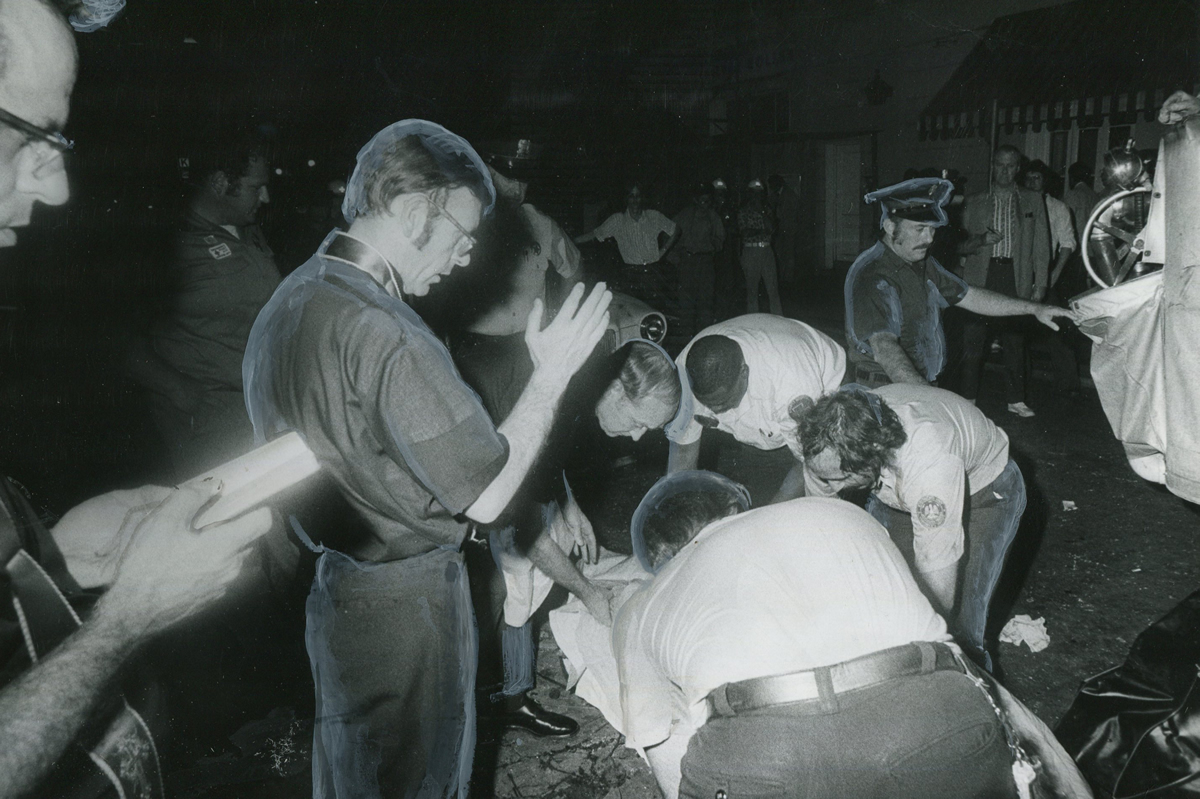
Esteve doubted the UpStairs Lounge story’s capacity to rouse gay political fervor. As the coroner buried four of his former patrons anonymously on the edge of town, Esteve quietly collected at least $25,000 in fire insurance proceeds. Less than a year later, he used the money to open another gay bar called the Post Office, where patrons of the UpStairs Lounge — some with visible burn scars — gathered but were discouraged from singing “United We Stand.”
New Orleans cops neglected to question the chief arson suspect and closed the investigation without answers in late August 1973. Gay elites in the city’s power structure began gaslighting the mourners who marched with Perry into the news cameras, casting suspicion on their memories and re-characterizing their moment of liberation as a stunt.
When a local gay journalist asked in April 1977, “Where are the gay activists in New Orleans?,” Esteve responded that there were none, because none were needed. “We don’t feel we’re discriminated against,” Esteve said. “New Orleans gays are different from gays anywhere else… Perhaps there is some correlation between the amount of gay activism in other cities and the degree of police harassment.”
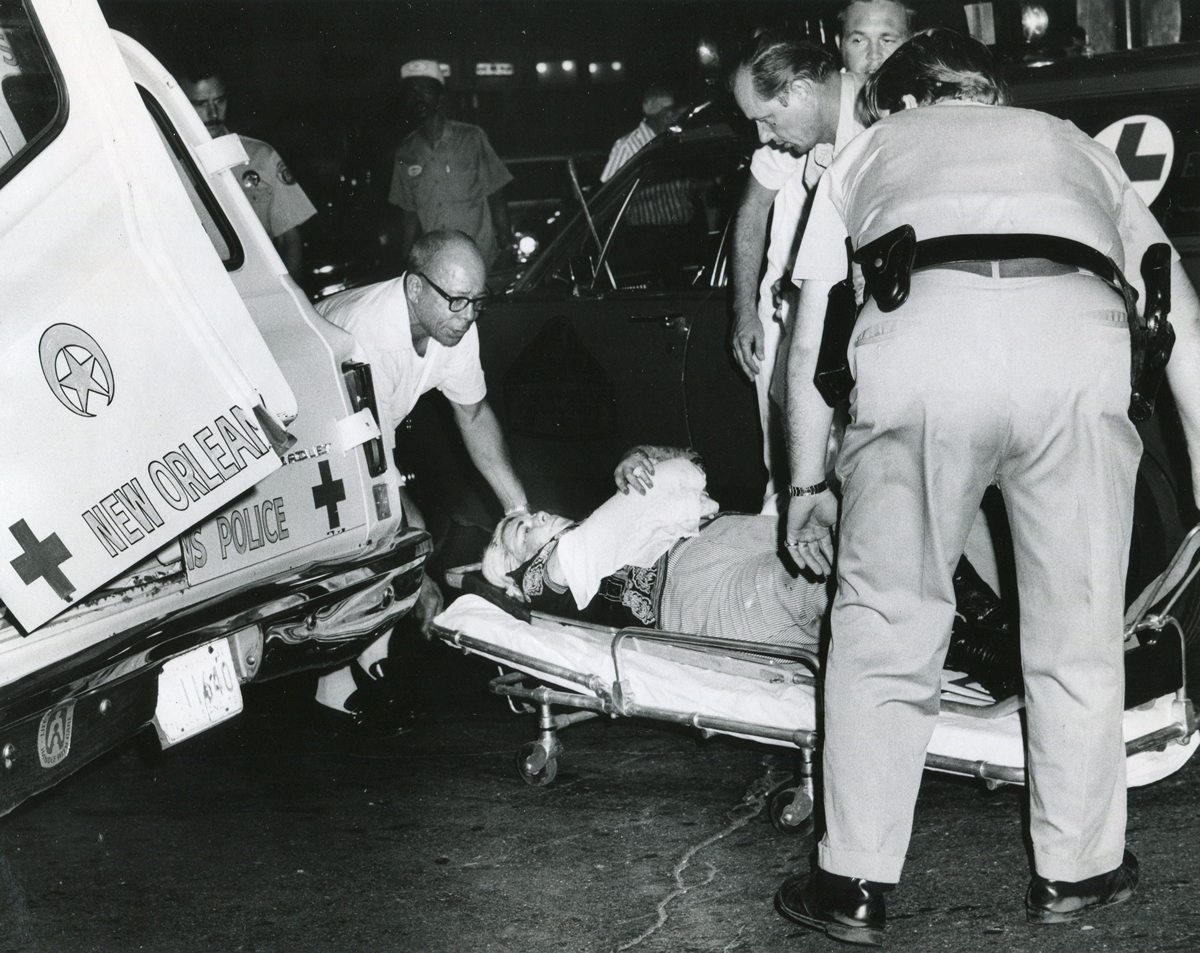
An attitude of nihilism and disavowal descended upon the memory of the UpStairs Lounge victims, goaded by Esteve and fellow gay entrepreneurs who earned their keep via gay patrons drowning their sorrows each night instead of protesting the injustices that kept them drinking.
Into the 1980s, the story of the UpStairs Lounge all but vanished from conversation — with the exception of a few sanctuaries for gay political debate such as the local lesbian bar Charlene’s, run by the activist Charlene Schneider.
By 1988, the 15th anniversary of the fire, the UpStairs Lounge narrative comprised little more than a call for better fire codes and indoor sprinklers. UpStairs Lounge survivor Stewart Butler summed it up: “A tragedy that, as far as I know, no good came of.”
Finally, in 1991, at Stewart Butler and Charlene Schneider’s nudging, the UpStairs Lounge story became aligned with the crusade of liberated gays and lesbians seeking equal rights in Louisiana. The halls of power responded with intermittent progress. The New Orleans City Council, horrified by the story but not yet ready to take its look in the mirror, enacted an anti-discrimination ordinance protecting gays and lesbians in housing, employment, and public accommodations that Dec. 12 — more than 18 years after the fire.
“I believe the fire was the catalyst for the anger to bring us all to the table,” Schneider told The Times-Picayune, a tacit rebuke to Esteve’s strategy of silent accommodation. Even Esteve seemed to change his stance with time, granting a full interview with the first UpStairs Lounge scholar Johnny Townsend sometime around 1989.
Most of the figures in this historic tale are now deceased. What’s left is an enduring story that refused to go gently. The story now echoes around the world — a musical about the UpStairs Lounge fire recently played in Tokyo, translating the gay underworld of the 1973 French Quarter for Japanese audiences.
When I finished my presentation to the City Council last June, I looked up to see the seven council members in tears. Unanimously, they approved a resolution acknowledging the historic failures of city leaders in the wake of the UpStairs Lounge fire.
Council members personally apologized to UpStairs Lounge families and survivors seated in the chamber in a symbolic act that, though it could not bring back those who died, still mattered greatly to those whose pain had been denied, leaving them to grieve alone. At long last, official silence and indifference gave way to heartfelt words of healing.
The way Americans remember the past is an active, ongoing process. Our collective memory is malleable, but it matters because it speaks volumes about our maturity as a people, how we acknowledge the past’s influence in our lives, and how it shapes the examples we set for our youth. Do we grapple with difficult truths, or do we duck accountability by defaulting to nostalgia and bluster? Or worse, do we simply ignore the past until it fades into a black hole of ignorance and indifference?
I believe that a factual retelling of the UpStairs Lounge tragedy — and how, 50 years onward, it became known internationally — resonates beyond our current divides. It reminds queer and non-queer Americans that ignoring the past holds back the present, and that silence is no cure for what ails a participatory nation.
Silence isolates. Silence gaslights and shrouds. It preserves the power structures that scapegoat the disempowered.
Solidarity, on the other hand, unites. Solidarity illuminates a path forward together. Above all, solidarity transforms the downtrodden into a resounding chorus of citizens — in the spirit of voices who once gathered ‘round a white baby grand piano and sang, joyfully and loudly, “United We Stand.”

Robert W. Fieseler is a New Orleans-based journalist and the author of “Tinderbox: the Untold Story of the Up Stairs Lounge Fire and the Rise of Gay Liberation.”
homepage news
New Supreme Court term includes critical LGBTQ case with ‘terrifying’ consequences
Business owner seeks to decline services for same-sex weddings
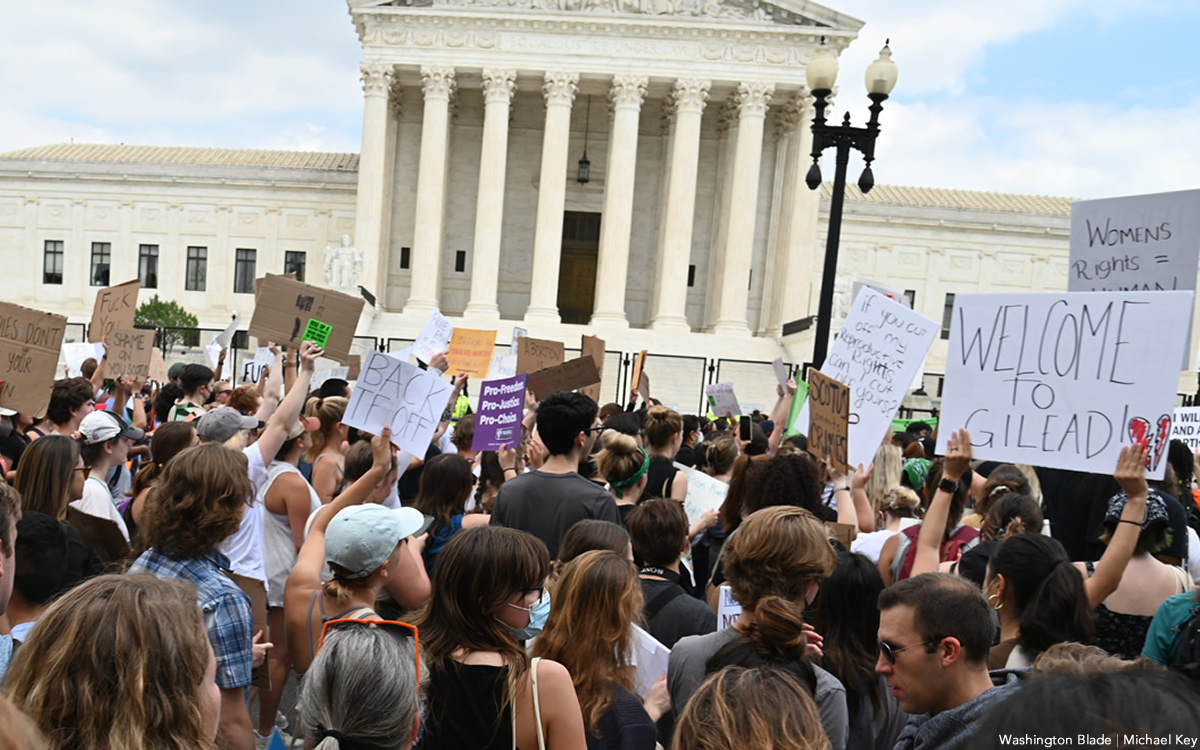
The U.S. Supreme Court, after a decision overturning Roe v. Wade that still leaves many reeling, is starting a new term with justices slated to revisit the issue of LGBTQ rights.
In 303 Creative v. Elenis, the court will return to the issue of whether or not providers of custom-made goods can refuse service to LGBTQ customers on First Amendment grounds. In this case, the business owner is Lorie Smith, a website designer in Colorado who wants to opt out of providing her graphic design services for same-sex weddings despite the civil rights law in her state.
Jennifer Pizer, acting chief legal officer of Lambda Legal, said in an interview with the Blade, “it’s not too much to say an immeasurably huge amount is at stake” for LGBTQ people depending on the outcome of the case.
“This contrived idea that making custom goods, or offering a custom service, somehow tacitly conveys an endorsement of the person — if that were to be accepted, that would be a profound change in the law,” Pizer said. “And the stakes are very high because there are no practical, obvious, principled ways to limit that kind of an exception, and if the law isn’t clear in this regard, then the people who are at risk of experiencing discrimination have no security, no effective protection by having a non-discrimination laws, because at any moment, as one makes their way through the commercial marketplace, you don’t know whether a particular business person is going to refuse to serve you.”
The upcoming arguments and decision in the 303 Creative case mark a return to LGBTQ rights for the Supreme Court, which had no lawsuit to directly address the issue in its previous term, although many argued the Dobbs decision put LGBTQ rights in peril and threatened access to abortion for LGBTQ people.
And yet, the 303 Creative case is similar to other cases the Supreme Court has previously heard on the providers of services seeking the right to deny services based on First Amendment grounds, such as Masterpiece Cakeshop and Fulton v. City of Philadelphia. In both of those cases, however, the court issued narrow rulings on the facts of litigation, declining to issue sweeping rulings either upholding non-discrimination principles or First Amendment exemptions.
Pizer, who signed one of the friend-of-the-court briefs in opposition to 303 Creative, said the case is “similar in the goals” of the Masterpiece Cakeshop litigation on the basis they both seek exemptions to the same non-discrimination law that governs their business, the Colorado Anti-Discrimination Act, or CADA, and seek “to further the social and political argument that they should be free to refuse same-sex couples or LGBTQ people in particular.”
“So there’s the legal goal, and it connects to the social and political goals and in that sense, it’s the same as Masterpiece,” Pizer said. “And so there are multiple problems with it again, as a legal matter, but also as a social matter, because as with the religion argument, it flows from the idea that having something to do with us is endorsing us.”
One difference: the Masterpiece Cakeshop litigation stemmed from an act of refusal of service after owner, Jack Phillips, declined to make a custom-made wedding cake for a same-sex couple for their upcoming wedding. No act of discrimination in the past, however, is present in the 303 Creative case. The owner seeks to put on her website a disclaimer she won’t provide services for same-sex weddings, signaling an intent to discriminate against same-sex couples rather than having done so.
As such, expect issues of standing — whether or not either party is personally aggrieved and able bring to a lawsuit — to be hashed out in arguments as well as whether the litigation is ripe for review as justices consider the case. It’s not hard to see U.S. Chief Justice John Roberts, who has sought to lead the court to reach less sweeping decisions (sometimes successfully, and sometimes in the Dobbs case not successfully) to push for a decision along these lines.
Another key difference: The 303 Creative case hinges on the argument of freedom of speech as opposed to the two-fold argument of freedom of speech and freedom of religious exercise in the Masterpiece Cakeshop litigation. Although 303 Creative requested in its petition to the Supreme Court review of both issues of speech and religion, justices elected only to take up the issue of free speech in granting a writ of certiorari (or agreement to take up a case). Justices also declined to accept another question in the petition request of review of the 1990 precedent in Smith v. Employment Division, which concluded states can enforce neutral generally applicable laws on citizens with religious objections without violating the First Amendment.
Representing 303 Creative in the lawsuit is Alliance Defending Freedom, a law firm that has sought to undermine civil rights laws for LGBTQ people with litigation seeking exemptions based on the First Amendment, such as the Masterpiece Cakeshop case.
Kristen Waggoner, president of Alliance Defending Freedom, wrote in a Sept. 12 legal brief signed by her and other attorneys that a decision in favor of 303 Creative boils down to a clear-cut violation of the First Amendment.
“Colorado and the United States still contend that CADA only regulates sales transactions,” the brief says. “But their cases do not apply because they involve non-expressive activities: selling BBQ, firing employees, restricting school attendance, limiting club memberships, and providing room access. Colorado’s own cases agree that the government may not use public-accommodation laws to affect a commercial actor’s speech.”
Pizer, however, pushed back strongly on the idea a decision in favor of 303 Creative would be as focused as Alliance Defending Freedom purports it would be, arguing it could open the door to widespread discrimination against LGBTQ people.
“One way to put it is art tends to be in the eye of the beholder,” Pizer said. “Is something of a craft, or is it art? I feel like I’m channeling Lily Tomlin. Remember ‘soup and art’? We have had an understanding that whether something is beautiful or not is not the determining factor about whether something is protected as artistic expression. There’s a legal test that recognizes if this is speech, whose speech is it, whose message is it? Would anyone who was hearing the speech or seeing the message understand it to be the message of the customer or of the merchants or craftsmen or business person?”
Despite the implications in the case for LGBTQ rights, 303 Creative may have supporters among LGBTQ people who consider themselves proponents of free speech.
One joint friend-of-the-court brief before the Supreme Court, written by Dale Carpenter, a law professor at Southern Methodist University who’s written in favor of LGBTQ rights, and Eugene Volokh, a First Amendment legal scholar at the University of California, Los Angeles, argues the case is an opportunity to affirm the First Amendment applies to goods and services that are uniquely expressive.
“Distinguishing expressive from non-expressive products in some contexts might be hard, but the Tenth Circuit agreed that Smith’s product does not present a hard case,” the brief says. “Yet that court (and Colorado) declined to recognize any exemption for products constituting speech. The Tenth Circuit has effectively recognized a state interest in subjecting the creation of speech itself to antidiscrimination laws.”
Oral arguments in the case aren’t yet set, but may be announced soon. Set to defend the state of Colorado and enforcement of its non-discrimination law in the case is Colorado Solicitor General Eric Reuel Olson. Just this week, the U.S. Supreme Court announced it would grant the request to the U.S. solicitor general to present arguments before the justices on behalf of the Biden administration.
With a 6-3 conservative majority on the court that has recently scrapped the super-precedent guaranteeing the right to abortion, supporters of LGBTQ rights may think the outcome of the case is all but lost, especially amid widespread fears same-sex marriage would be next on the chopping block. After the U.S. Tenth Circuit Court of Appeals ruled against 303 Creative in the lawsuit, the simple action by the Supreme Court to grant review in the lawsuit suggests they are primed to issue a reversal and rule in favor of the company.
Pizer, acknowledging the call to action issued by LGBTQ groups in the aftermath of the Dobbs decision, conceded the current Supreme Court issuing the ruling in this case is “a terrifying prospect,” but cautioned the issue isn’t so much the makeup of the court but whether or not justices will continue down the path of abolishing case law.
“I think the question that we’re facing with respect to all of the cases or at least many of the cases that are in front of the court right now, is whether this court is going to continue on this radical sort of wrecking ball to the edifice of settled law and seemingly a goal of setting up whole new structures of what our basic legal principles are going to be. Are we going to have another term of that?” Pizer said. “And if so, that’s terrifying.”
homepage news
Kelley Robinson, a Black, queer woman, named president of Human Rights Campaign
Progressive activist a veteran of Planned Parenthood Action Fund
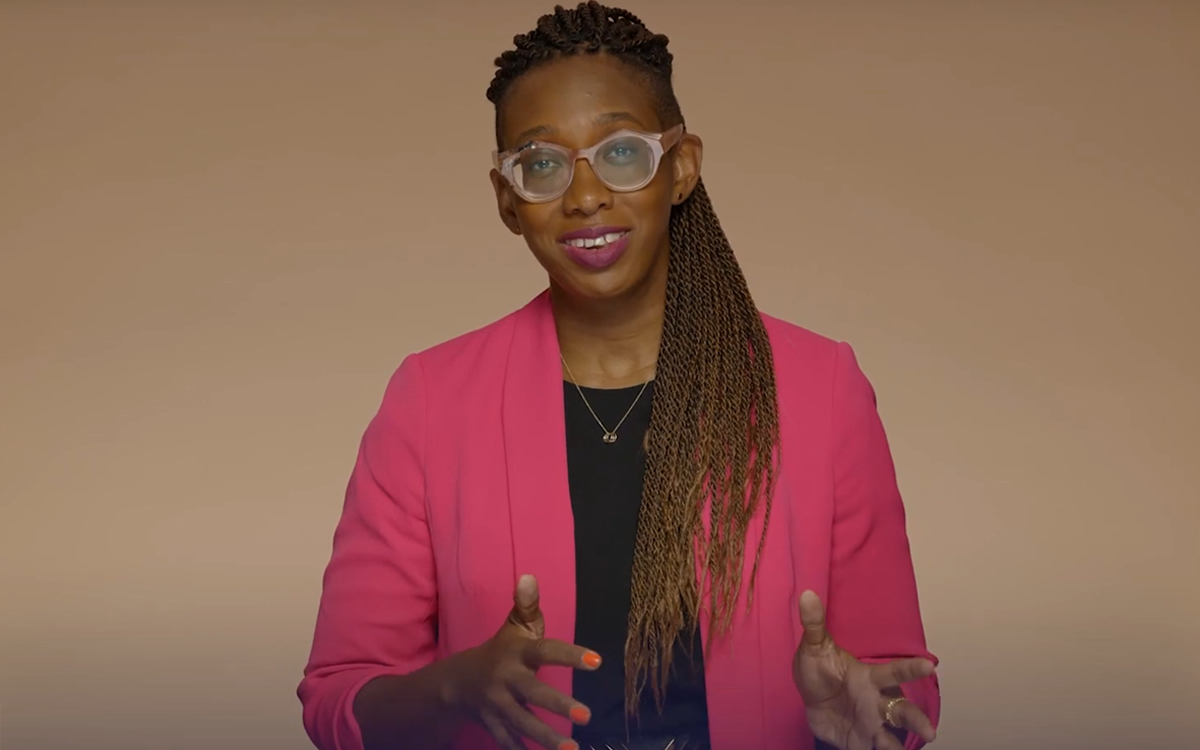
Kelley Robinson, a Black, queer woman and veteran of Planned Parenthood Action Fund, is to become the next president of the Human Rights Campaign, the nation’s leading LGBTQ group announced on Tuesday.
Robinson is set to become the ninth president of the Human Rights Campaign after having served as executive director of Planned Parenthood Action Fund and more than 12 years of experience as a leader in the progressive movement. She’ll be the first Black, queer woman to serve in that role.
“I’m honored and ready to lead HRC — and our more than three million member-advocates — as we continue working to achieve equality and liberation for all Lesbian, Gay, Bisexual, Transgender, and Queer people,” Robinson said. “This is a pivotal moment in our movement for equality for LGBTQ+ people. We, particularly our trans and BIPOC communities, are quite literally in the fight for our lives and facing unprecedented threats that seek to destroy us.”
The next Human Rights Campaign president is named as Democrats are performing well in polls in the mid-term elections after the U.S. Supreme Court overturned Roe v. Wade, leaving an opening for the LGBTQ group to play a key role amid fears LGBTQ rights are next on the chopping block.
“The overturning of Roe v. Wade reminds us we are just one Supreme Court decision away from losing fundamental freedoms including the freedom to marry, voting rights, and privacy,” Robinson said. “We are facing a generational opportunity to rise to these challenges and create real, sustainable change. I believe that working together this change is possible right now. This next chapter of the Human Rights Campaign is about getting to freedom and liberation without any exceptions — and today I am making a promise and commitment to carry this work forward.”
The Human Rights Campaign announces its next president after a nearly year-long search process after the board of directors terminated its former president Alphonso David when he was ensnared in the sexual misconduct scandal that led former New York Gov. Andrew Cuomo to resign. David has denied wrongdoing and filed a lawsuit against the LGBTQ group alleging racial discrimination.
